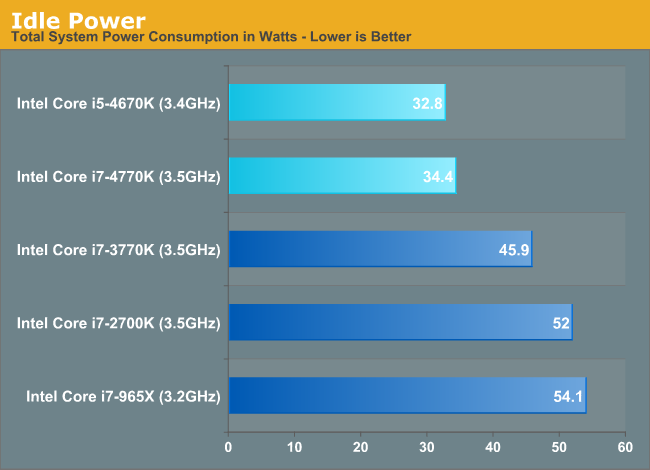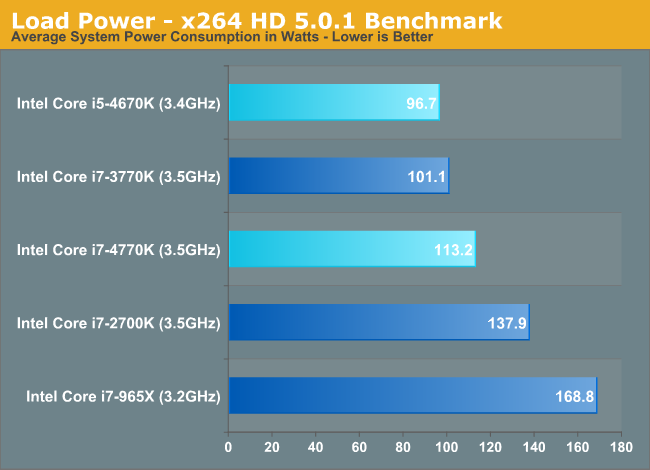The Haswell Review: Intel Core i7-4770K & i5-4670K Tested
by Anand Lal Shimpi on June 1, 2013 10:00 AM ESTPower Improvements
Although Haswell’s platform power is expected to drop considerably in mobile, particularly with Haswell U and Y SKUs (Ultrabooks and ultrathins/tablets), there are benefits to desktop Haswell parts as well.
There’s more fine grained power gating, lower chipset power and the CPU cores can transition between power states about 25% quicker than in Ivy Bridge - allowing the power control unit to be more aggressive in selecting lower power modes. We’ve also seen considerable improvements on lowering platform power consumption at the motherboard level as well. Using ASUS’ Z77 Deluxe and Z87 Deluxe motherboards for the Haswell, Ivy and Sandy Bridge CPUs, I measured significant improvements in idle power consumption:

These savings are beyond what I’d expect from Haswell alone. Intel isn’t the only one looking to make things as best as can be in the absence of any low hanging fruit. The motherboard makers are aggressively polishing their designs in order to grow their marketshare in a very difficult environment.
Under load, there’s no escaping the fact that Haswell can burn more power in pursuit of higher performance:

Here I’m showing an 11.8% increase in power consumption, and in this particular test the Core i7-4770K is 13% faster than the i7-3770K. Power consumption goes up, but so does performance per watt.
The other big part of the Haswell power story is what Intel is calling FIVR: Haswell’s Fully Integrated Voltage Regulator. Through a combination of on-die and on-package circuitry (mostly inductors on-package), Haswell assumes responsibility of distributing voltages to individual blocks and controllers (e.g. PCIe controller, memory controller, processor graphics, etc...). With FIVR, it’s easy to implement tons of voltage rails - which is why Intel doubled the number of internal voltage rails. With more independent voltage rails, there’s more fine grained control over the power delivered to various blocks of Haswell.
Thanks to a relatively high input voltage (on the order of 1.8V), it’s possible to generate quite a bit of current on-package and efficiently distribute power to all areas of the chip. Voltage ramps are 5 - 10x quicker with FIVR than with a traditional on-board voltage regulator implementation.
In order to ensure broad compatibility with memory types, there’s a second input voltage for DRAM as well.
FIVR also comes with a reduction in board area and component cost. I don’t suppose this is going to be a huge deal for desktops (admittedly the space and cost savings are basically non-existent), but it’ll mean a lot for mobile.
No S0ix for Desktop
You’ll notice that I didn’t mention any of the aggressive platform power optimizations in my sections on Haswell power management, that’s because they pretty much don’t apply here. The new active idle (S0ix) states are not supported by any of the desktop SKUs. It’s only the forthcoming Y and U series parts that support S0ix.










210 Comments
View All Comments
JDG1980 - Saturday, June 1, 2013 - link
Those tests you linked are purely synthetic benchmarks. Has anyone found a significant real-world application where Haswell is slower than SB/IB at the same clock speed?krumme - Saturday, June 1, 2013 - link
Has anyone found a significal real-world application where Haswell matter?smilingcrow - Saturday, June 1, 2013 - link
Has anyone found a significant real-world comment from you that matters?rupert3k - Saturday, June 1, 2013 - link
*high fives*Aditya211935 - Sunday, June 2, 2013 - link
http://www.techoftomorrow.com/2013/pc/intel-haswel...This One is pretty nice.
Altough the list of games given there is a bit shallow but still it gives you a general idea.
jeffkibuule - Saturday, June 1, 2013 - link
Haswell isn't just about the CPU, it's about the entire platform of chips, even the tiny ones on the motherboard no one really cares about. And I'm not sure what you were expecting in terms of performance gains, as there isn't any competition in the desktop arena for it to be worth pushing out 20-25% gains (and certainly not on a yearly basis).As far as active power goes, the entire point of a modern CPU architecture is to "hurry up and go to sleep (HUGS)". Faster you go to idle and the better idle performance you have, the better battery life you get because lets face it, unless you're encoding a video or playing a game, your CPU spends most of its idling doing nothing.
B3an - Saturday, June 1, 2013 - link
You're right. If anyone is to be blamed for the slight performance increase of Haswell, it's AMD. If AMD could actually compete on performance we would be seeing more gains with Haswell, and maybe FINALLY more than 4 cores on mainstream Intel platforms.DeadlyRicochet - Tuesday, June 4, 2013 - link
And I wonder how successful AMD would have been if Intel never stole their revenue (when AMD chips were faster than Intel, around 2006) by making under the table deals with OEMs to use Intel only CPUs.deepblue08 - Saturday, June 1, 2013 - link
I disagree somewhat. Especially with the fact that you think idle power consumption is unimportant. Keep in mind, that at least half of the time, when you are working, browsing the net, your cpu is in fact idle. So an improvement in idle performance consumption is a big deal imo.Hector2 - Saturday, June 1, 2013 - link
You've got it all wrong. Haswell won't be going up against ARM in tablets. Don't look for it in smartphones either ! LOL A Haswell i7 is serious overkill for those markets. ARM won't be getting into the serious laptop & PC market soon either --- they just can't compete well with Intel there. Intel is targeting their smaller & less power-hungry Atoms for the phone & tablet markets (surely you know this ?) that are driven by low power requirements. The press just leaked that Samsung's new Galaxy Tab 3 will have dual core Clover Trail+ Atoms